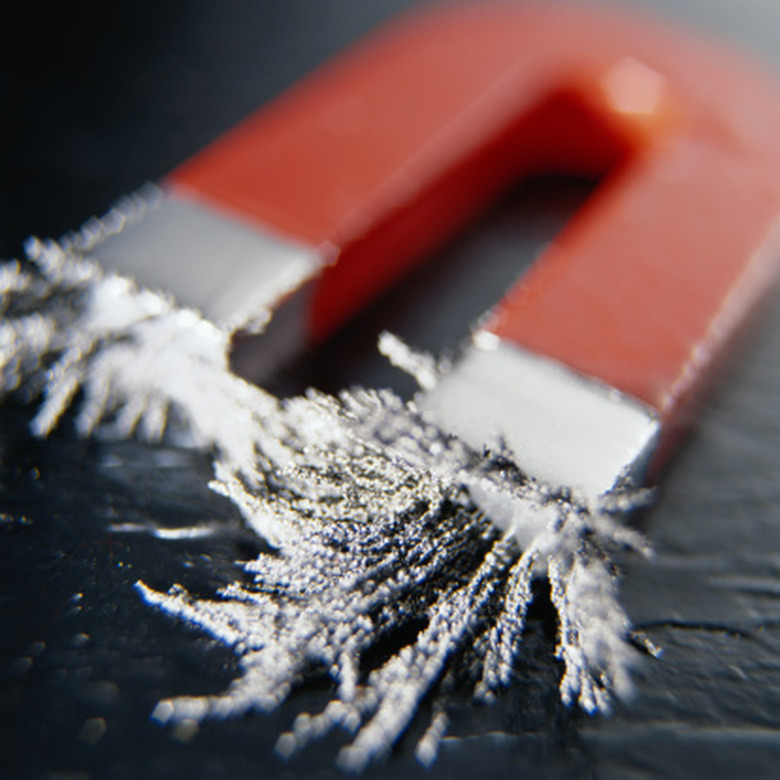List Of Ferromagnetic Metals
Ferromagnetism, the ability of a substance to magnetize, is a property that depends on the chemical composition, crystalline structure, temperature and microscopic organization of the material. Metals and alloys are most likely to exhibit ferromagnetism, but even lithium gas has also been shown to be magnetic when cooled to less than one Kelvin. Cobalt, iron and nickel are all common ferromagnets.
TL;DR (Too Long; Didn't Read)
Magnetite is technically not a metal. Although it has a metallic finish, Fe3O4 is formed by the oxidation of iron into an oxide.
Cobalt
Cobalt
Cobalt, one of the transition metals, has a Curie temperature of 1388 k. The Curie temperature is the maximum temperature at which a ferromagnetic metal exhibits ferromagnetism. Transition metals are the elements found in the center of the periodic table and are characterized by their inconsistent, incomplete outer electron shell. Cobalt has been used to create strong magnets for carbon nanotubes and electronics.
Iron
Iron
Iron is another transition metal and has a Curie temperature of 1043 k. It is amorphous (non-crystalline, unlike many other ferromagnets). Magnetic iron is used in power generation and distribution, nanowires and shape-memory alloys.
Nickel
Nickel
Nickel is another amorphous transition metal and has a Curie temperature of 627 k. It can be magnetized in the laboratory by rapid quenching (the scientific term for sudden cooling) the liquid alloy.
Gadolinium
Gadolinium
Gadolinium is a silvery-white, highly ductile rare earth metal used as a neutron absorber in nuclear reactors. It has a Curie temperature of 292 k and strong paramagnetic properties.
Dysprosium
Dysprosium
Dysprosium, has a Curie temperature of 88 k. It is another rare earth element with a metallic silvery luster and is more commonly found inside minerals such xenotime instead of a freely occurring, natural substance. Dysprosium has a high magnetic susceptibility, which means it is easily polarized in the presence of strong magnets.
Permalloy
Permalloy
Permalloy-based structures are ferromagnetic metals made of different proportions of iron and nickel. Permalloy is an active, tunable material which can be used in microwave devices or in tiny, single chip electronics. By altering the ratio of iron and nickel in the composition, the properties of the permalloy can be subtly changed. A 45 percent nickel, 55 percent iron composite is referred to as a "45 permalloy."
Awaruite
Awaruite
A rare, black-gray alloy of nickel and iron with a chemical formula of Ni3Fe, awaruite was found in California and is displayed at the Smithsonian Museum of Natural History. Specimens of this rare substance are used to study the composition of meteorites and in other investigative geological applications.
Wairakite
Wairakite
An alloy of cobalt and iron, wairakite is classified as a primary mineral and is found in Tohi, Shizuoka and Chubu, Japan. A primary mineral is a sample of igneous rock which was formed in the first stage of solidification from the original molten magma. They contrast to the secondary minerals, which form after initial solidification, during weathering processes or geothermal changes.
Magnetite
Magnetite
Magnetite, Fe3O4, is a ferromagnetic mineral with a metallic finish. It is formed by the oxidation of iron into an oxide. Although it is not technically a metal, it is one of the most magnetic substances known and was the key to early understandings of magnets.
Cite This Article
MLA
Parks, Natasha. "List Of Ferromagnetic Metals" sciencing.com, https://www.sciencing.com/list-ferromagnetic-metals-8479101/. 5 April 2018.
APA
Parks, Natasha. (2018, April 5). List Of Ferromagnetic Metals. sciencing.com. Retrieved from https://www.sciencing.com/list-ferromagnetic-metals-8479101/
Chicago
Parks, Natasha. List Of Ferromagnetic Metals last modified August 30, 2022. https://www.sciencing.com/list-ferromagnetic-metals-8479101/
